You’ll need a visual reminder to help you stay on track with your chain. You could use a traditional wall calendar. The chains.cc app was created specifically for the Don’t Break the Chain method. Alternatively, you could use Google Calendar, Notion, or a tally app.
9 Study Techniques Like Pomodoro: The Best Alternatives to Use
Pomodoro is touted as the one study method to rule them all, but some people find the Pomodoro method too restrictive. If you’re trying to develop an idea for a new short story or write an essay, you might need more than 25 minutes to fully flex your creative muscles. And if you work for an hour without stopping, you’ll need longer than a 5-minute break to let your brain rest.
If Pomodoro doesn’t suit your workflow, you’ll find plenty of other helpful study techniques like it. Read on to learn about some of the best alternatives to Pomodoro!
At the end, if you decide you do want to keep moving with the Pomodoro technique, check out our aesthetic Pomodoro timer – complete with a slew of timer and aesthetic theme options.
Looking for more Pomodoro timers or ways to reset between study sessions? Read our blog post where we outline our favorite Pomodoro break ideas, along with our favorite study timers!
Want more productivity tips? Join our mailing list below!

Flocus is a free browser-based dashboard for both focus and ambience. Featuring aesthetic themes, personal greeting Pomodoro timer, and lots more!
Get early access to Flocus here.
Flowtime Technique
Best for: Maintaining your own unique flowstate while still allowing for breaks
If frequent, rigid breaks disrupt your workflow rather than improving it, try the Flowtime technique. Like Pomodoro, Flowtime involves working for a set period and then taking a break.
However, the Flowtime technique works with your brain by letting you set the duration of your work sessions and breaks. This flexibility helps you stay in your creative flow and prevents disruptions to your train of thought.
To use the Flowtime technique, you’ll need to log your productivity. Record when you start working and when you get distracted. Note how long you worked on a task, how often you got distracted, the length of your breaks, and when you stopped working.
This is a flexible study technique with only one strict rule: you have to focus on one task at a time — no multitasking!
Here’s a step-by-step guide on how to use the Flowtime technique:
- Track your work and break times using a spreadsheet, Notion, or your preferred method (check out this template here).
- Decide which task you’re working on.
- Note what time you started working on your task.
- Work until you feel you need a break, whether you’re tired or distracted. Make a note of why you were distracted.
- Write down the length of your break.
- Repeat steps 1 to 5 for the rest of your work session.
- Record what time you finished working.
- Review your log to find your productivity flow.
Once you’ve recorded a few sessions using this technique, you can identify patterns. For example, you might find that you tend to feel “in the zone” around 9 AM. Use this info to schedule tasks during your peak productive times.
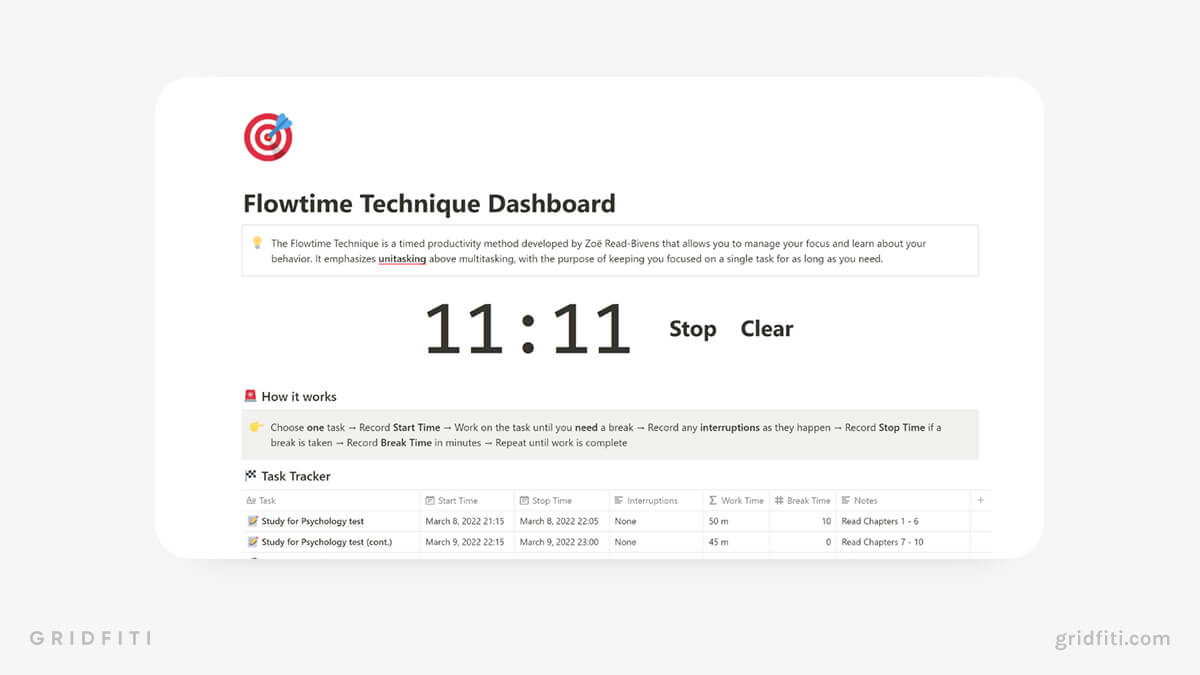
Animedoro Technique
Best for: Rewarding yourself for completing your to-do list
Animedoro gives Pomodoro a modern update. It’s ideal if you find yourself distracted by your favorite TV shows. Animedoro follows a similar structure to the Pomodoro technique of 25 minutes of work with 5-minute breaks. Then after four short breaks, you can take a longer break of around 15 minutes.
Many people don’t find these 5-minute breaks satisfying. You barely have time to make yourself something to eat.
Animedoro mixes things up with 40 to 60 minutes of focused work, followed by a 20-minute break where you watch an episode of your favorite anime or TV shows.
Watching a whole episode of a show you enjoy feels rewarding and helps you decompress. You’ll also be working for a longer period, which means you can fully finish tasks without as many interruptions.
To get started with the Animedoro technique, head over to Flocus’ Animedoro timer!
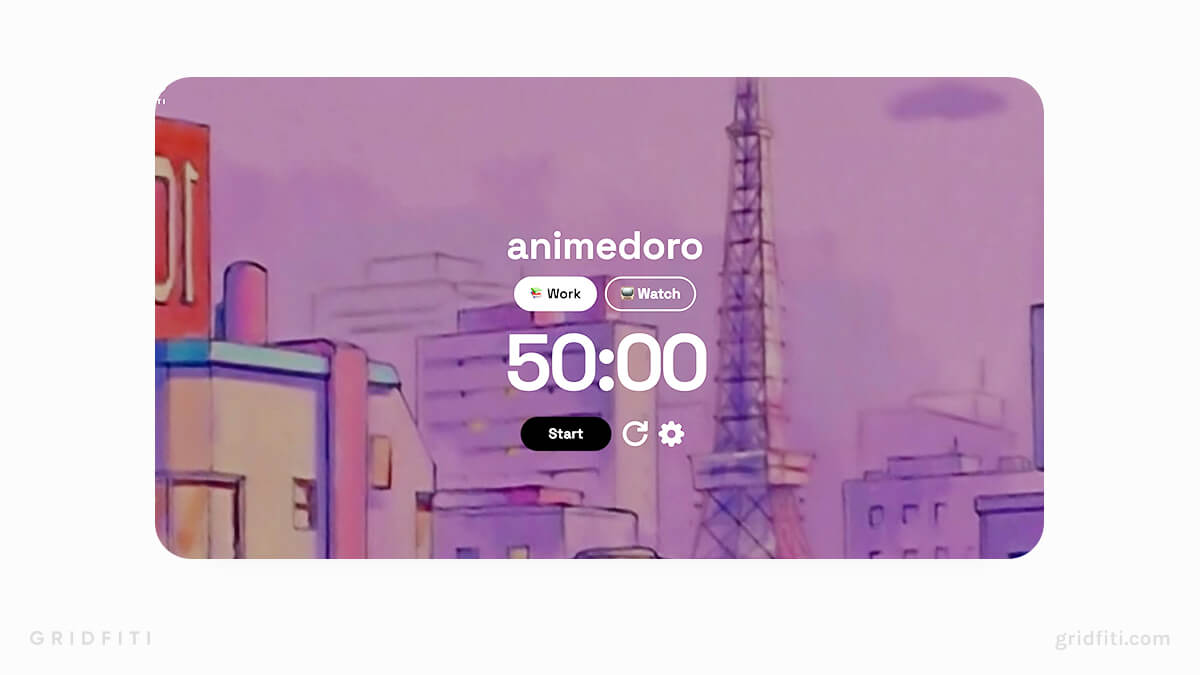
Time Blocking and Time Boxing Method
Best for: Visualizing your schedule and productivity
Time blocking and time boxing are similar (but separate) techniques that involve blocking off time, typically on a calendar, to complete tasks. They’re ideal if you’re juggling several projects simultaneously. Let’s take a look at each method.
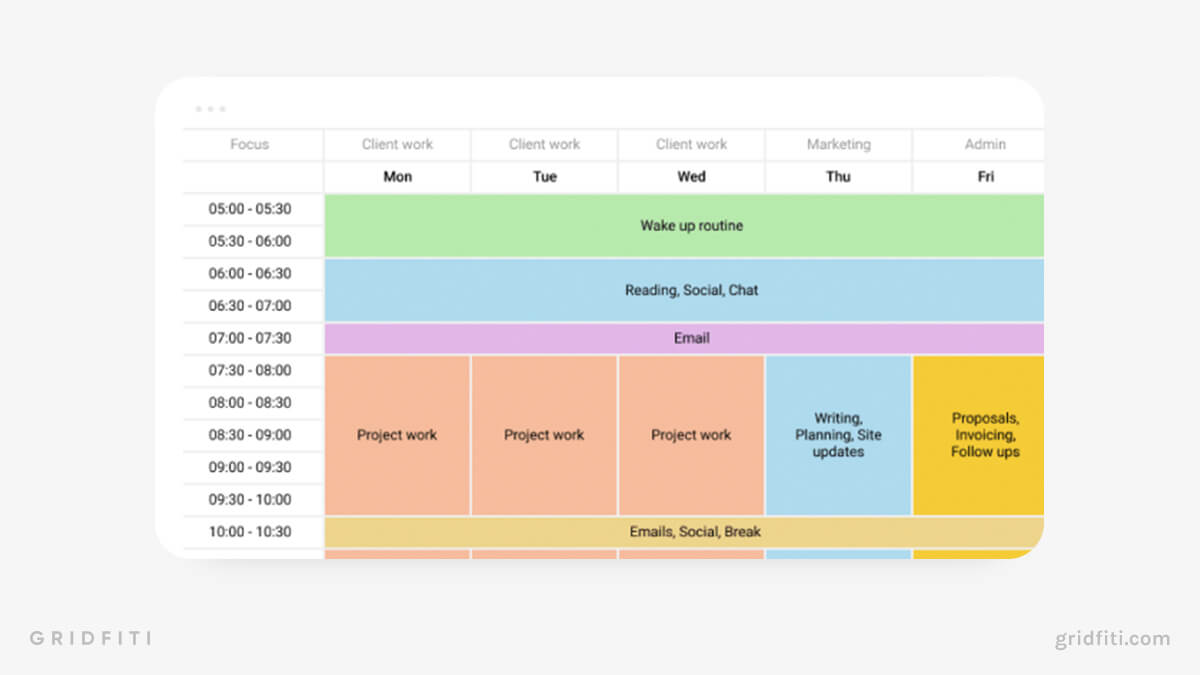
Visual via Clockify
Time blocking
With time blocking, you decide what you’ll work on and exactly when you’ll work on it — for example, “I’ll work on my essay on Monday between 3 PM and 4 PM.”
Many people use time blocking to map out their whole day or week across multiple tasks and projects. For example, you might have one time block for cleaning the kitchen, another for working on your essay, and another for cooking dinner all in the same day.
By visually blocking off time to work on a task, you’ll subconsciously work toward staying on schedule, even if your task doesn’t necessarily need to be finished during that block.
Time blocks are flexible, which means you could keep working on an assignment past 4 PM if you feel up to it. Or something might come up at 3 PM that requires you to move the block altogether.
At the end of the day, you can review your time blocks to see which ones you didn’t stick to. Then, update the rest of your time blocks accordingly.
Time boxing
Time boxing involves setting a strict deadline for when the work will be completed. So if you box off 3 PM to 4 PM to work on your essay, you’ll stop working right at 4 PM as planned.
While time blocks tend to be shorter, time boxes can span days, weeks, and even months. Because there’s always a hard deadline involved, this method is great for managing big projects.
The best way to lay out time blocking and time boxing is by color coding your Google Calendar with different blocks for different tasks. Notion is also a great tool for time blocking and time boxing. Check out our Notion Time Blocking and Time Boxing Templates and Guide for more info!
Eat That Frog Technique
Best for: Tackling important or difficult tasks
The Eat That Frog technique comes from a Mark Twain quote:
“Eat a live frog first thing in the morning and nothing worse will happen to you the rest of the day.”
“Eating a live frog” is a metaphor for completing the most difficult task first. And while Twain mentions the morning in his quote, you don’t necessarily need to be an early riser to benefit from this method.
This method tends to work well for several reasons. Getting difficult tasks out of the way keeps you motivated and productive (and also ensures your high-priority tasks are already done by the time the afternoon slump hits).
Tips for the Eat That Frog technique:
- Identify your difficult task the night before.
- Don’t plan too far in advance; focus only on your next task.
- Organize your tasks in order of difficulty and priority.
- Eat your frog first thing before starting any other task.
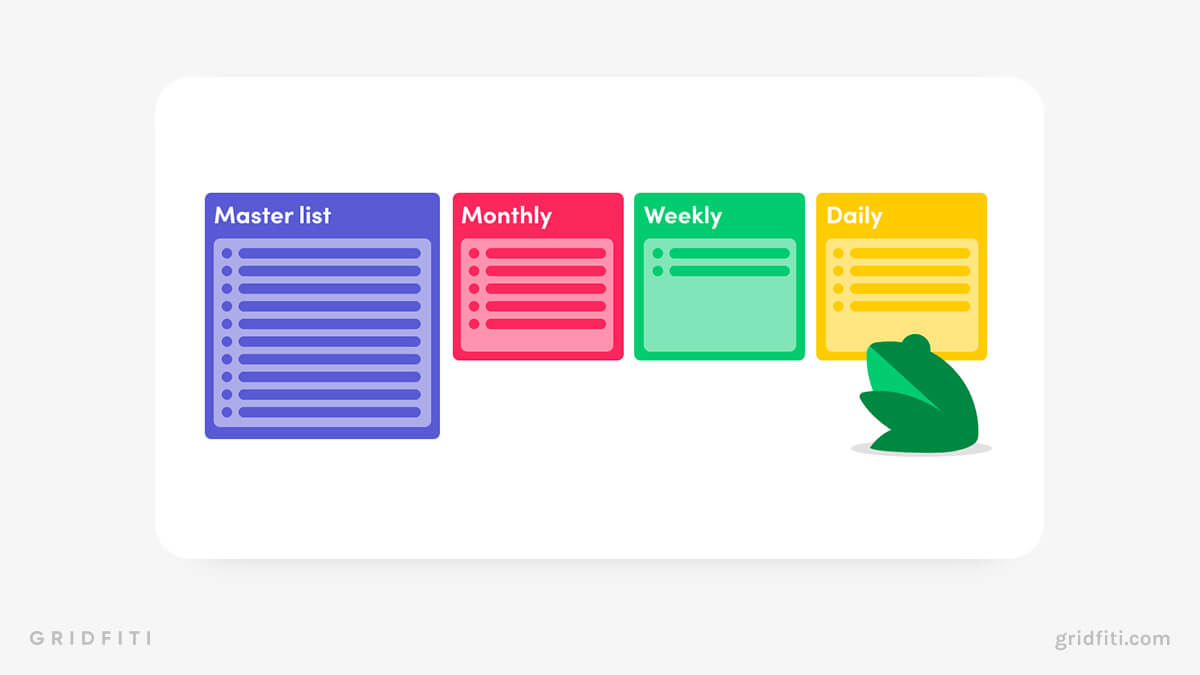
Visual via Monday.com
52/17 Rule
Best for: Pomodoro enthusiasts who need longer study sessions and breaks
The 52/17 Rule is based on a study published in The Muse. The study looked at the most productive users of the DeskTime app and their work patterns. The researchers found that the most productive users, on average, worked for 52 minutes before taking a 17-minute break.
This method relies on the “100% dedication theory”, which means you’re fully invested and focused on your work during the 52 minutes. Then, during your break, you’re fully removed from your work and resting, without checking emails or scrolling on social media.
The 52/17 Rule is very similar to Pomodoro, but again relies on the idea that more than 25 minutes of focused work is needed to accomplish large tasks.
Plus, a 17-minute break is far more satisfying and helps you refresh your attention span. Taking a complete rest during this time avoids what the study refers to as “cognitive boredom.” Working for several hours in a row means you lose focus — a complete break helps your brain refresh.
To try the 52/17 Rule right away, you can use our aesthetic Pomodoro timer or minimalist Pomodoro timer, either online or embedded in your Notion workspace, and customize the number of minutes for your Pomodoro and break in the settings panel!
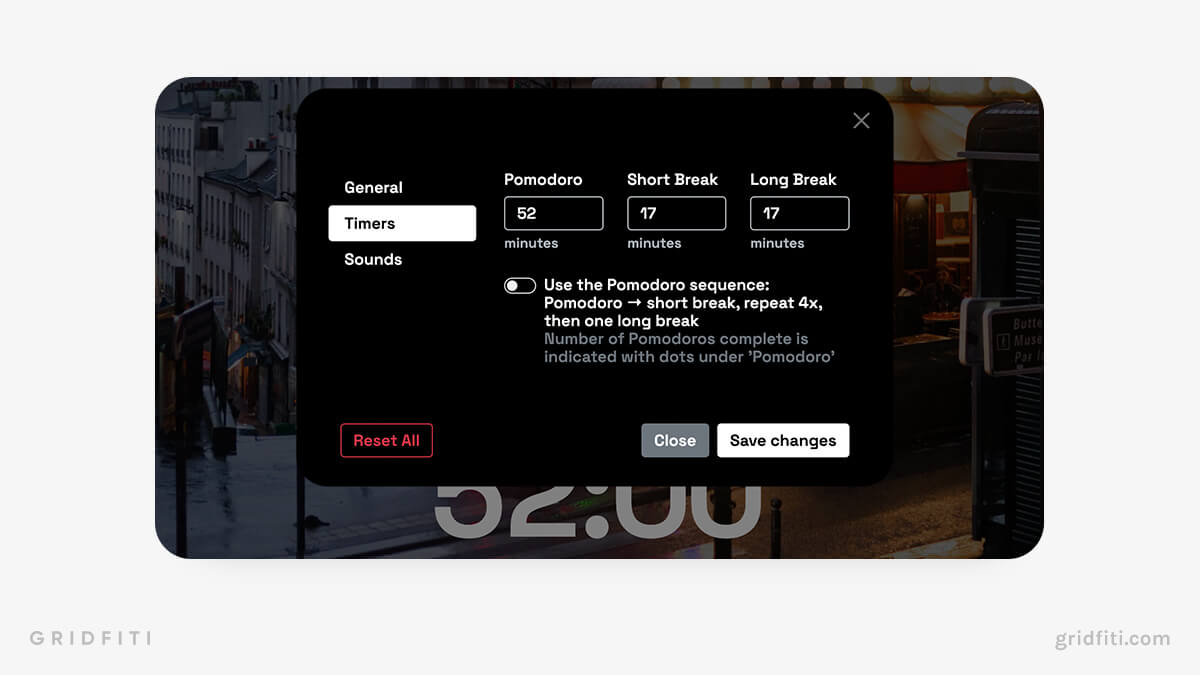
Eisenhower Matrix
Best for: Prioritizing, delegating, and eliminating tasks
President Dwight D. Eisenhower invented the Eisenhower Matrix to help him navigate difficult tasks.
The Eisenhower Matrix splits tasks up into 4 quadrants:
- Do first: Includes tasks you need to accomplish immediately, which have strict deadlines
- Schedule: Includes long-term assignments without an immediate deadline that can be scheduled for the future or later in the day
- Delegate: Includes tasks that need doing but aren’t urgent and can be assigned to someone else
- Don’t do: Includes distracting jobs that aren’t compulsory which you don’t need to complete
How does this work in practice? Let’s say you’re a content marketing manager at a start-up with 5 tasks on your to-do list:
- Finalize this month’s content calendar
- Source images for this week’s scheduled blog posts
- Create a list of articles that need to be audited
- Attend an optional stand-up with other team members
- Edit a blog post that’s being published in 2 weeks
Which quadrants are best for these tasks? That all depends on specific variables, like:
- Whether the task is time-sensitive. Finalizing the month’s content calendar is a high-priority task that must be completed by a certain date. So we’d put it in the “do first” quadrant.
- How far out your deadline is. If you’ve got tasks on your plate that aren’t due for another few weeks, place them in the “schedule” quadrant.
- The resources and people power available to you. Do you have a virtual assistant or a teammate to help you? If so, put low-priority tasks (like sourcing images) in the “delegate” quadrant.
- Whether certain tasks are mandatory. If you know you have a lot of work to do and you have optional meetings on your calendar, place them in the “don’t do” category to give yourself more time to spend on high-priority tasks.
You can keep the Eisenhower Matrix organized by limiting the graph to no more than 10 tasks. Limiting your workload will allow you to complete or eliminate tasks quicker without becoming overwhelmed. You could also try color-coding each quadrant to clearly understand what’s truly urgent.
If you’re looking to use the Eisenhower Matrix in Notion, we’ve curated the best Notion Eisenhower Matrix templates here for you to get started.
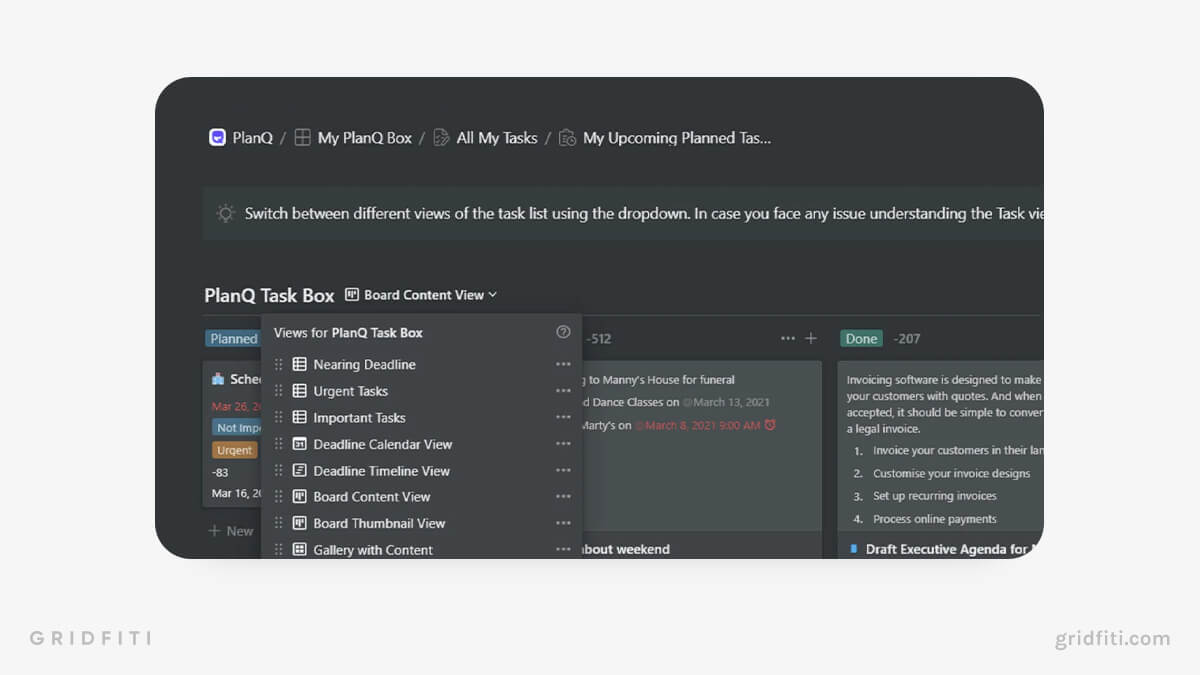
Using Study Discord Servers
Best for: Improving productivity through virtual study buddies
Since schools are designed to foster community, studying solo can be tough. Discord study servers connect you with other people who are studying, working, or doing something creative.
You can find servers that have accountability buddies to keep you motivated and even servers that gamify your workload to make your day-to-day tasks more engaging.
You’ll find hundreds of study discord servers on disboard.org. Let’s take a look at some of the most popular.
Gridfiti Discord Server
The Gridfiti Discord server is full of likeminded people who love to get things done – and that doesn’t stop at studying! With a dedicated study channel, and even virtual libraries to do live ‘study with me’ sessions both text and (silent) audio channels. Check out our server to maximize your study motivation!

Study Together
Study Together is one of the largest study Discord servers, with over 420,000 members. Arrange video calls and live chats, study with custom-made bots, or track your study time and compete with others on the leaderboard.
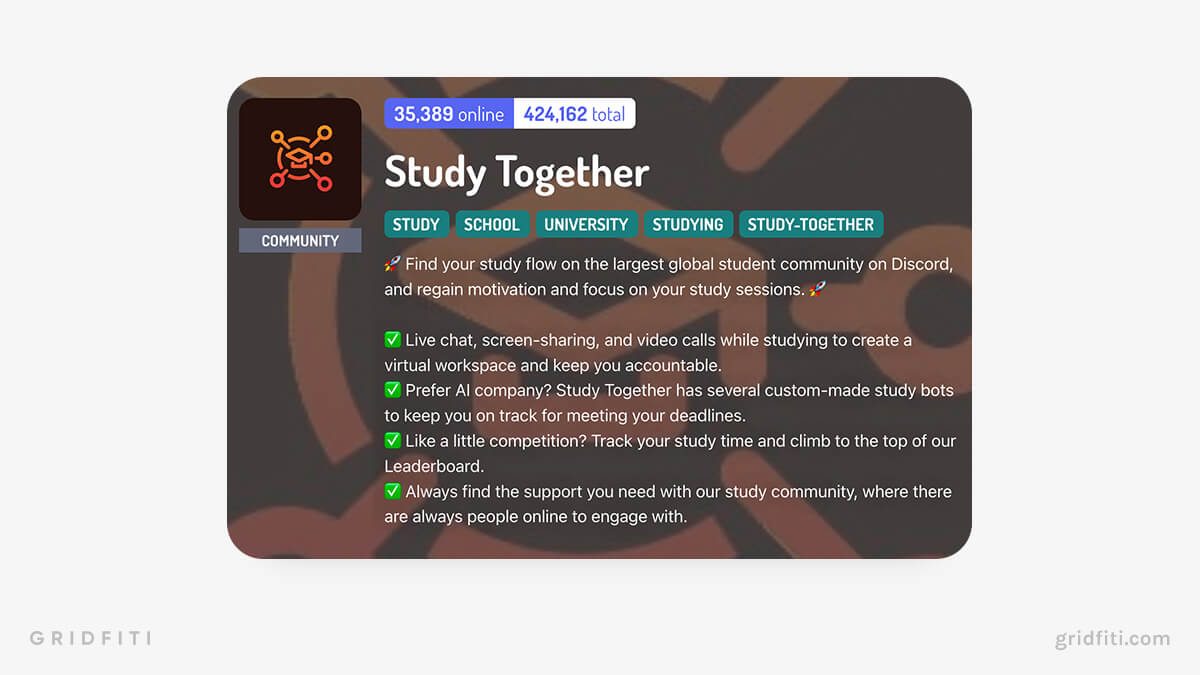
Homework Help
Homework Help combines a study Discord with a virtual tutoring service. Get help with your assignments from the server’s dedicated volunteers and work with other students to overcome learning obstacles.
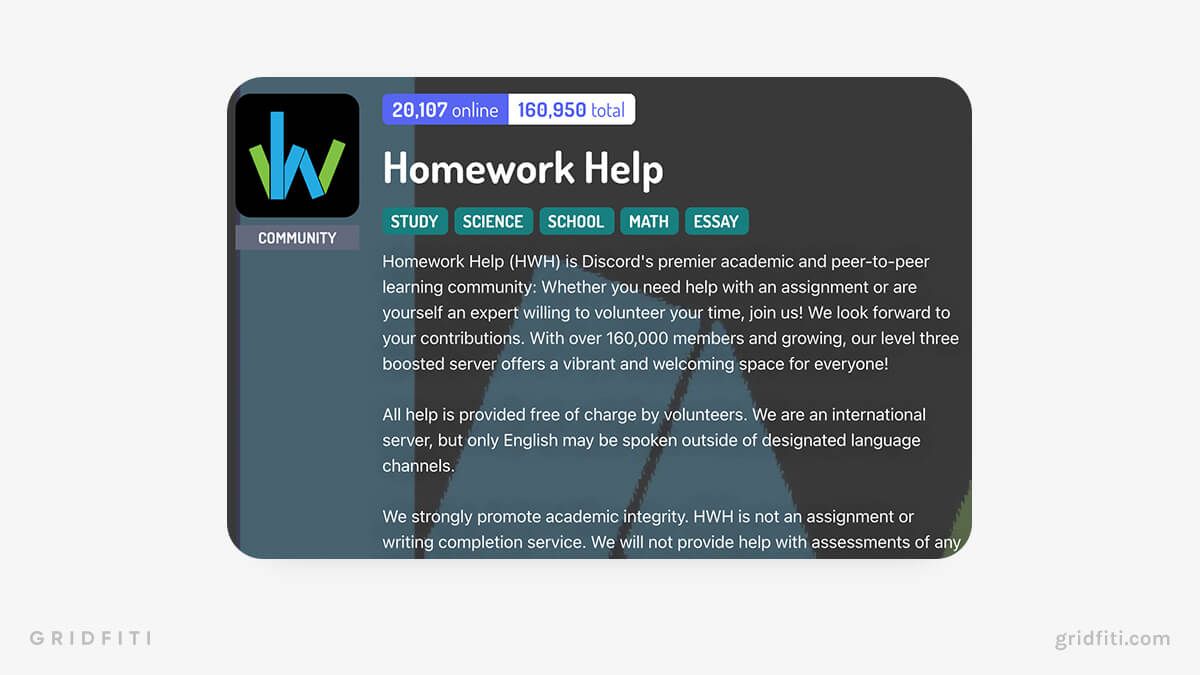
The Language Zone
The Language Zone is one of the best Discord servers for learning another language and immersing yourself in different cultures. Take free weekly lessons on various languages, play games to improve your vocab, and participate in weekly events.
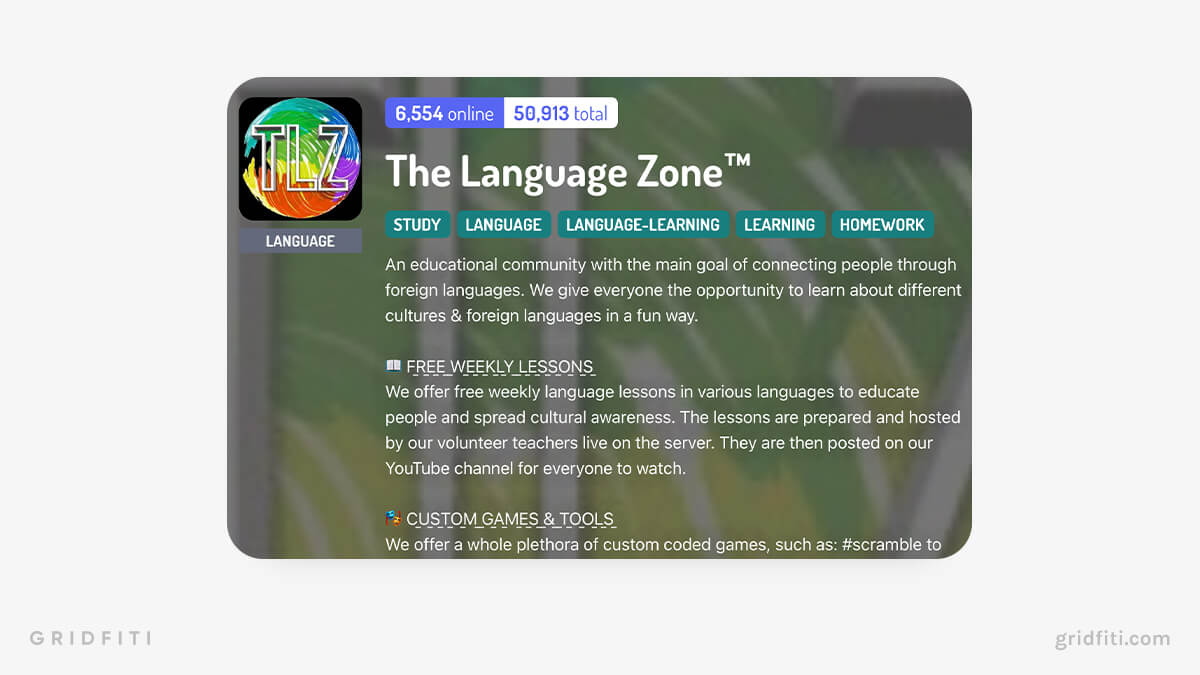
GTD Method
Best for: Capturing all your ideas and managing big projects
Getting Things Done (GTD) is a time management technique originally described by productivity consultant David Allen.
According to the GTD method, keeping too much information in your brain often means you spend more time thinking and fretting about doing tasks than actually doing them. The GTD method involves getting tasks out of your mind and organized in an external system, whether it be a notebook, task management app, or something else.
Recording your tasks in a “second brain” helps you focus on what’s important and ensures all those brilliant ideas that come to you in the shower get captured and remembered.
The GTD method revolves around five “fundamentals:”
- Record: Gather your tasks and information in an organization tool or database.
- Clarify: Decide whether a task is actionable or can be deleted, referenced, or put on hold.
- Organize: Arrange your categorized tasks with reminders based on their importance.
- Reflect: Regularly review your tasks and categories to stay up to date.
- Engage: Use your organizational tool to make decisions on assignments.
The GTD method is super helpful if you often feel overwhelmed from juggling different responsibilities or sometimes forget small details.
One key to the GTD method is to have the right organizational tool. Here are some of the best apps to download for the GTD method:
- Notion | GTD templates here
- Todoist
- Evernote
- ProofHub
- Nifty
- Nirvana
- TickTick
- Google Keep
- Trello
- Asana
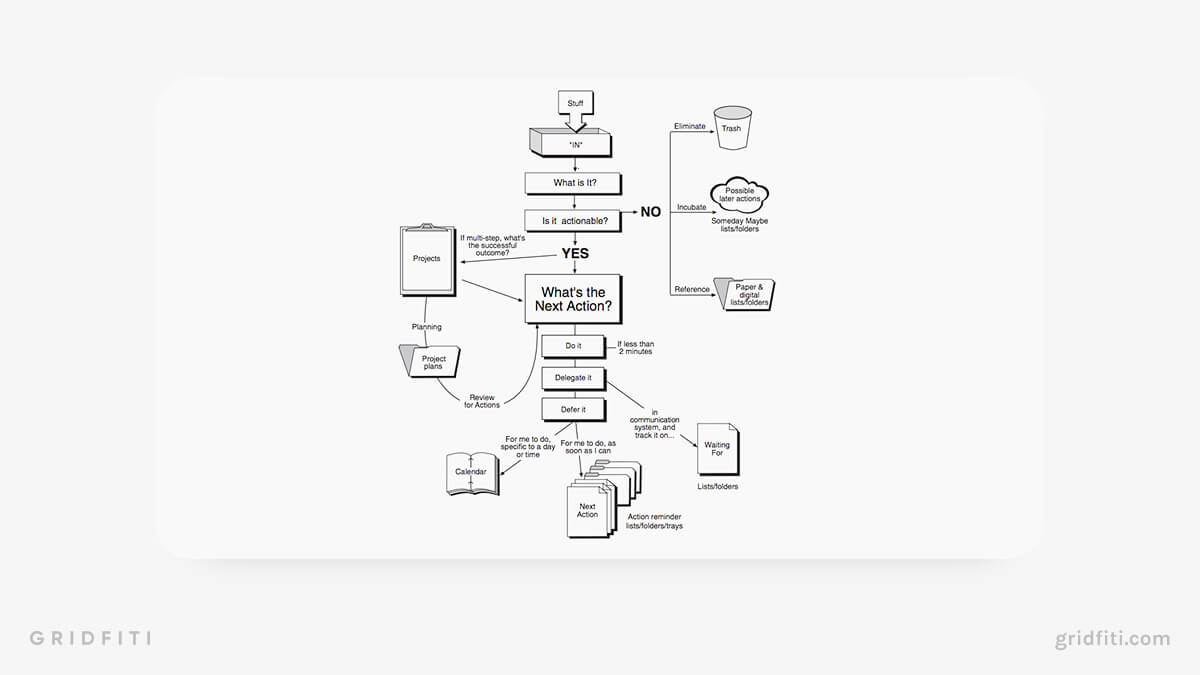
Visual via Zapier
Don’t Break the Chain (Seinfeld) Method
Best for: Building consistency by maintaining a study streak
Comedian Jerry Seinfeld once shared some advice that can help improve your consistency and work ethic:
Seinfeld told a young comedian that they should try to write a new joke daily to improve. When Seinfeld was starting out, he had a big calendar in his apartment, and for every day he wrote a new joke, he would put a big red “X” on that day.
After a few days, he had an unbroken chain of crosses, creating a visual reminder that motivated him to keep working and not break the chain. Building a chain like this makes completing your daily goal a habit. Habits are hard to establish, but once established, they’re hard to break.
The best way to accomplish the Don’t Break the Chain method is to pick an important but easy task to achieve daily. Start with a task so simple that there’s no way you can avoid completing it. Keep at it, and it’ll eventually become a part of your daily routine.
When you’re first starting out, avoid the temptation to aim too high or go too big. For example, writing several thousand words every day probably isn’t sustainable. Instead, try setting a goal of just one paragraph or page per day.
You’ll need a visual reminder to help you stay on track with your chain. You could use a traditional wall calendar. The chains.cc app was created specifically for the Don’t Break the Chain method. Alternatively, you could use Google Calendar, Notion, or a tally app.

Which study technique like Pomodoro do you see yourself using? Any other Pomodoro alternatives to recommend? Let us know in the comments below!
Gridfiti is supported by its audience – when you buy something using the retail links in our posts, we may earn a small commission at no additional cost to you. Read more about our affiliate disclaimer.
The Best Pomodoro Alternatives for Effective Time Management in 2023
In a world of constant distractions and ever-increasing demands, time management has become a crucial skill for success and well-being.
The Pomodoro technique, with its structured work intervals and short breaks, has been a favorite among productivity enthusiasts. However, it may not suit everyone’s needs.
Today, we will explore some of the best alternatives to the Pomodoro technique that can revolutionize the way you approach productivity.
Now, let’s discover some Pomodoro alternatives for increased productivity and better time management.

Free eBook: Work smart, not hard with your team!
Top Productivity Tips for Teams and Their Leaders
10 Best Pomodoro alternatives
1. Time tracking
The time tracking time management technique involves monitoring and recording the time spent on various tasks, activities, or projects throughout the day.
It aims to increase awareness of how you use your time, identify areas for improvement, and optimize productivity and efficiency.
How the time tracking technique works
- Choose a time tracking method: select a time tracking method that suits your preference and lifestyle. You can use a traditional paper journal, a spreadsheet, or time tracking apps and software for computers and mobile devices.
- Start tracking: begin tracking your time by recording the start and end times for each task or activity you engage in throughout the day.
- Be specific: when tracking your time, be as specific as possible.
- Analyze the data: after tracking your time for a few days or weeks, review the data to identify patterns and trends. Look for areas where you spend more time than expected or areas where time is wasted.
- Make adjustments: use the insights gained from time tracking to make adjustments to your daily routines, prioritize tasks, and improve time management.
Why the perfect Pomodoro alternative is time tracking
- Increased time awareness: time tracking helps you become more aware of how you spend your time.
- Improved productivity: by tracking your time, you can identify time-wasting activities and inefficiencies.
- Accurate planning: with data on how long tasks take to complete, you can make more accurate estimates for future projects and plan your schedule more effectively.
- Enhanced accountability: time tracking holds you accountable for how you use your time, encouraging you to stay focused and on track with your tasks.
- Stress reduction: understanding where your time goes can help reduce stress by optimizing your schedule and avoiding over-committing.
- Work-life balance: time tracking allows you to assess how well you balance work and personal life
Curiosity: Did you know that time tracking is an effective time management hack?

Tired of the Pomodoro technique?
Uplift your productivity with time tracking! Get deeper insights on where you really spend your time. Be more accountable and focused!
Pros and cons of Time Tracking
| Pros | Cons |
|---|---|
| Increases time awareness | With the wrong app or method, it can be time-consuming and tedious |
| Improves productivity | |
| Allows accurate planning | |
| Reduces stress | |
| Promotes work-life balance |
2. The task batching approach

If you find it challenging to switch between different types of tasks, the task batching approach might be what you need.
Instead of dividing your day into small intervals, group similar tasks together and tackle them consecutively during dedicated “batching” sessions.
How task batching works
- Identify similar tasks: start by categorizing your tasks based on similarity or relatedness.
- Set time blocks: allocate specific time blocks in your schedule for each task category.
- Focus on one category: during each time block, focus solely on tasks from the designated category.
- Limit distractions: minimize distractions during your time blocks to make the most of your focused work.
- Complete tasks in batches: work through the tasks in each category one after another, completing as many as possible within the allocated time block.
- Take short breaks: after completing a batch of tasks or at the end of each time block, take short breaks to rest and recharge before moving on to the next batch.
Pros and cons of Task Batching
| Pros | Cons |
|---|---|
| Improves focus | Not be appropriate for all tasks |
| Reduces procrastination | Limited flexibility |
| Streamlines your workflow | Rigid schedule |
| Enhances efficiency | |
| Promotes mental clarity |
3. Eat the Frog

The “Eat the Frog” technique is a reliable Pomodo alternative since it encourages individuals to tackle their most challenging or dreaded task first thing in the morning.
The concept is derived from Mark Twain’s quote: “Eat a live frog first thing in the morning, and nothing worse will happen to you the rest of the day.”
How Eat the Frog works
- Identify the most important task: begin your day by identifying the most critical, high-priority, or challenging task. This is the “frog” you need to “eat.”
- Start with the frog: once you’ve identified the frog, commit to working on it first thing in the morning before you move on to any other tasks or distractions.
- Choose the next task (or “frog”): once you’ve finished working on the first task, identify the next one and continue the process until you’ve completed all your tasks.
Pros and cons of Eat the Frog
| Pros | Cons |
|---|---|
| Increases productivity | Not suited for all tasks |
| Reduces procrastination | Lack of motivation in the morning can be hard to overcome |
| Gives you a clearer focus | |
| Improves time management | |
| Reduces stress |
4. The time blocking system
The time blocking time management system is an adaptive and dynamic alternative to fixed time intervals.
Break your day into time blocks dedicated to a specific task or project. Within each block, allow yourself to work at your own pace without rigid constraints.
Once the block ends, take a brief break to recharge and evaluate your progress.
Curiosity: Did you know that Tesla’s CEO uses this method? Get to know everything in our post: Elon Musk’s time management.
How Time Blocking works
- List your tasks: start by listing all the tasks, projects, appointments, and activities you need to accomplish during the day.
- Allocate time blocks: assign specific time blocks for each task or group of related tasks. Arrange your time blocks based on priority and importance.
- Set realistic durations: when allocating time for each task, be realistic about how long it will take to complete.
- Create a schedule: use a calendar or planner to create a visual representation of your time blocks for the day.
Pros and cons of Time Blocking as Pomodoro alternative
| Pros | Cons |
|---|---|
| Enhances focus | Rigid schedule |
| Improves time management | It can be overwhelming to organize a large number of tasks |
| Reduces procrastination | Lack of flexibility |
| Provides you with better planning skills | |
| Promotes work-life balance |
Note: Remember to include breaks and to be flexible in case something doesn’t go as planned.
5. The reverse pomodoro strategy
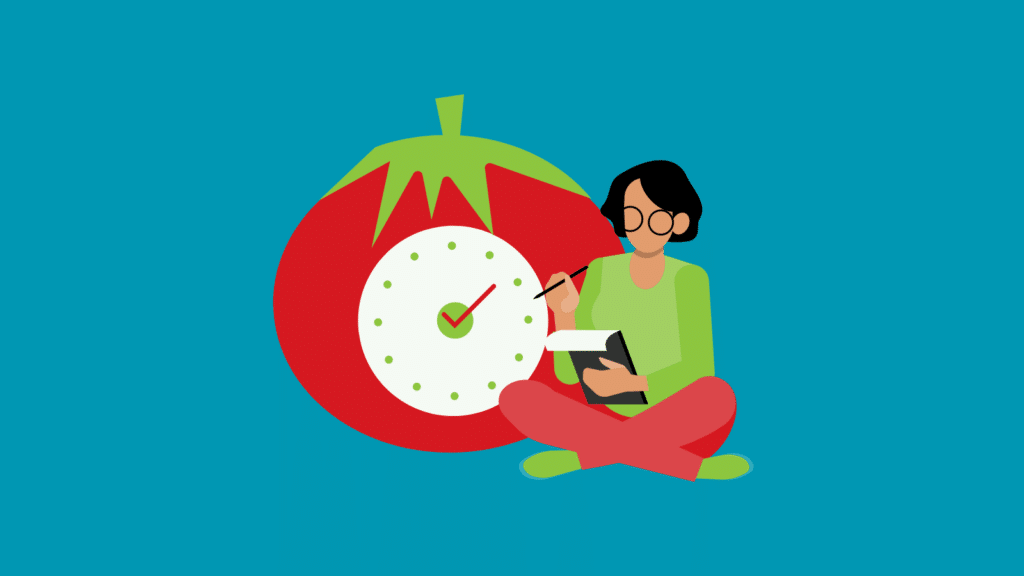
The Reverse Pomodoro Strategy flips the conventional approach on its head, emphasizing longer work intervals and shorter breaks.
Engage in an uninterrupted deep work session, ranging from 45 to 90 minutes, followed by a quick, active break of 5 to 10 minutes.
The Reverse Pomodoro Strategy is particularly effective for deep thinkers and creative problem-solvers.
How the reverse pomodoro works
- Take a break: before you start working, take a small break. During this break time, step away from your work or task and engage in a relaxing or rejuvenating activity, like stretching, taking a short walk, deep breathing, or anything that helps you recharge.
- Work intensely: Enter a focused work interval. Work on your task or project with full concentration and productivity for as long as you need or wish to.
- Take a break: Once you feel like you need to, take another break. Set a timer for a short break, typically around 5 to 10 minutes.
- Repeat the cycle: Continue this cycle of taking breaks before each work session and adjusting the break and work durations based on your productivity and energy levels.
Pros and cons of Reverse Pomodoro alternative
| Pros | Cons |
|---|---|
| Allows for deeper focus | It can lead to burnout |
| Minimizes interruptions | Reduces rest and recovery periods |
| Increases productivity | Can put a physical strain on your body |
| Improves task completion rates | |
| Promotes work-life balance |
6. 4 quadrants of time management

The 4 quadrants of time management, also known as the Eisenhower Matrix, is a time management tool that helps individuals prioritize tasks based on their urgency and importance.
It was popularized by the 34th President of the United States, Dwight D. Eisenhower, who was known for his ability to make efficient and quick decisions and manage his time effectively.
How the Eisenhower Matrix works
The matrix categorizes tasks into four quadrants based on two criteria: urgency and importance. Here’s how the Eisenhower Matrix is structured:
- Quadrant 1: Urgent and Important (Do First): Tasks in this quadrant are both urgent and important, requiring immediate attention. They are critical to your goals and often have impending deadlines. These tasks demand immediate action and should be handled as a top priority.
- Quadrant 2: Important but Not Urgent (Schedule): Tasks in this quadrant are essential for achieving your long-term goals but do not require immediate attention. These tasks are often overlooked or postponed because they lack urgency, but they contribute significantly to your success.
- Quadrant 3: Urgent but Not Important (Delegate): Tasks in this quadrant are urgent but do not contribute significantly to your long-term goals. They are distractions that can consume your time and energy if not managed appropriately. Consider delegating or automating these tasks whenever possible.
- Quadrant 4: Not Urgent and Not Important (Eliminate): Tasks in this quadrant are neither urgent nor important and often represent time-wasting activities. Engaging in activities from this quadrant can prevent you from focusing on what truly matters. It’s best to eliminate or minimize these tasks to free up time for higher-priority activities.
By focusing on Quadrant 1 and Quadrant 2 tasks, which are both important and contribute to long-term success, individuals can become more effective and productive in their personal and professional lives.
Pros and cons of Time Management Quadrants
| Pros | Cons |
|---|---|
| Give you a more clear view of your tasks | Oversimplifies task division |
| Increases time management | It can lead to delegation challenges |
| Reduces procrastination | Some tasks might be hard to adapt to the matrix |
| Improves decision-making | |
| Reduces stress |
7. The 80/20 Rule (Pareto Principle)

The Pareto Principle, also known as the 80/20 rule or the law of the vital few, suggests that a significant portion of results (approximately 80%) comes from a relatively small proportion of inputs or efforts (approximately 20%).
The principle is named after the Italian economist Vilfredo Pareto, who observed this pattern in wealth distribution in Italy in the late 19th century.
How the Pareto Principle works
In time management, the Pareto Principle considers that roughly 80% of your productivity may result from focusing on the top 20% of high-value tasks.
With this in mind, you should identify and prioritize the high-value tasks that can improve your productivity and focus on them.
By focusing on the vital few, you can optimize your time and resources to achieve better results more efficiently.
Keep in mind that the specific ratios may vary in different situations; it’s not always a precise 80/20 split. It could be 70/30, 90/10, or similar proportions.
Pros and cons of Pareto’s Principle as an alternative to Pomodoro
| Pros | Cons |
|---|---|
| It leads to a more efficient resource allocation | It’s not always exact |
| Improves tasks prioritization | It can lead to delegation challenges |
| Reduces procrastination | Difficulty in identifying the high-value tasks – it might be subjective |
| Strategic Planning |
8. Getting Things Done (GTD) Method
The “Getting Things Done” (GTD) method is a popular time management technique and productivity system created by David Allen.
The GTD method is a great replacement for the Pomodoro method because it provides a framework for capturing, organizing, and managing tasks and commitments to reduce stress and improve productivity.
How the GTD method works
- Capture: collect all your tasks, ideas, and commitments in a trusted system, whether it’s a physical notebook, digital app, or any other tool.
- Clarify: process the items you’ve captured one by one and decide on the next action required for each. If a task can be completed in two minutes or less, do it immediately. If it requires more time or effort, delegate it, defer it to a specific time, or categorize it for later review.
- Organize: group similar tasks and commitments into relevant categories or lists. Common categories may include “Work,” “Personal,” “Errands,” “Calls,” and more.
- Reflect: regularly review your lists and commitments to ensure they align with your goals and priorities.
- Engage: when it’s time to work, focus solely on the tasks you’ve identified in your system without worrying about the ones you’re not currently addressing.
Pros and cons of the Getting Things Done Method
| Pros | Cons |
|---|---|
| Promotes a comprehensive organization method | Longer initial setup time |
| Reduces stress | Complex learning curve |
| Focuses on next actions | It can be complex |
| Improves decision-making skills | |
| It’s based on flexibility | |
| Encourages maintaining a clear, calm mind |
9. Timeboxing

The timebox technique, also known as timeboxing, is a time management method that involves allocating a fixed and predetermined amount of time to complete a task or activity.
Timeboxing is a reliable Pomodoro alternative because you set a specific time limit, known as a “timebox,” and work on the task only during that period. When the time is up, you stop working on the task, regardless of whether it’s completed.
How the timebox technique works
- Set a goal: define the task or activity you want to work on and set a clear goal or outcome you want to achieve within the given time.
- Determine the timebox: decide the amount of time you will dedicate to the task. Common timeboxes range from 15 minutes to two hours, depending on the complexity and nature of the task.
- Focus and work: during the timebox, focus solely on the task at hand and work with concentration and dedication to achieve the goal within the allocated time.
- Time awareness: keep track of the time remaining during the timebox to ensure you stay on track and complete the task within the allocated time frame.
- Stop and evaluate: when the time is up, stop working on the task, even if it’s not fully completed. Take a moment to evaluate your progress, record any unfinished tasks, and decide on the next steps.
Pros and cons of timeboxing
| Pros | Cons |
|---|---|
| Improves focus | Can be too rigid for some tasks |
| Allows you to avoid procrastination | Can create stress and pressure |
| Creates an effective task allocation system | Timeboxes might not be sufficient to complete complex or lengthy tasks |
| Promotes a sustainable work pace | Transitioning between timeboxes might require mental effort |
| It can be unrealistic for meetings |
10. The Energy Mapping Strategy
Recognizing that our energy levels fluctuate throughout the day, the Energy Mapping Strategy tailors your schedule to align with your natural rhythms.
Identify your high-energy and low-energy periods, and plan your work accordingly.
How the Energy Mapping strategy works
Reserve challenging and demanding tasks for when your energy peaks and tackle less demanding activities during your low-energy moments.
By synchronizing your work with your body’s natural flow, you optimize productivity while preventing burnout.
Pros and Cons of the Energy Mapping Strategy
| Pros | Cons |
|---|---|
| Improves focus | No suitable for office work |
| Respect for the body’s natural rhythm | Lack of consistency |
| Creates an effective task allocation system | Lack of organization |
| Promotes a sustainable work pace |
Conclusion
In the pursuit of productivity, the Pomodoro technique has been a game-changer for many. However, the world of time management offers a lot of creative alternatives that cater to diverse work styles and preferences.
Each technique offers a unique perspective on optimizing productivity and enhancing well-being.
As you try to master time management, consider experimenting with these 10 Pomodoro alternatives. Embrace the one that resonates most with you and be open to adapting and evolving your approach as you grow.
Remember, productivity is not just about maximizing output. It’s about finding a balance that allows you to thrive in both your personal and professional endeavors. Happy time management!
You might be interested in:
- Statistics about time management
- How to improve time management skills
- The 4 D’s of time management
- Free online time management training
- Time management as a soft skill
- Time management training for employees
Receive more resources like this in your inbox!
Subscribe to our monthly Newsletter!

